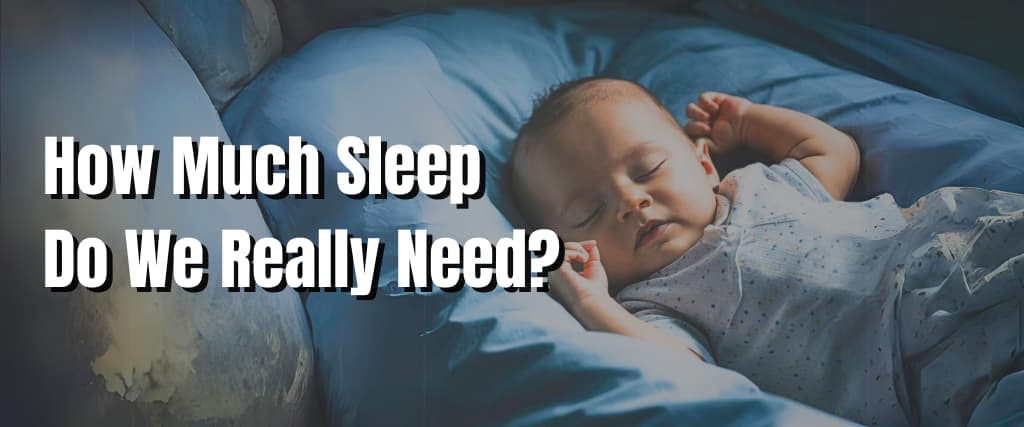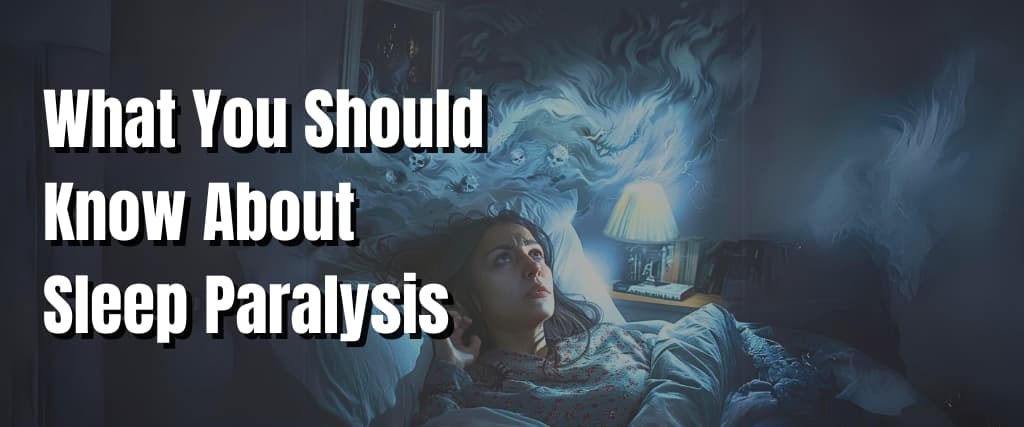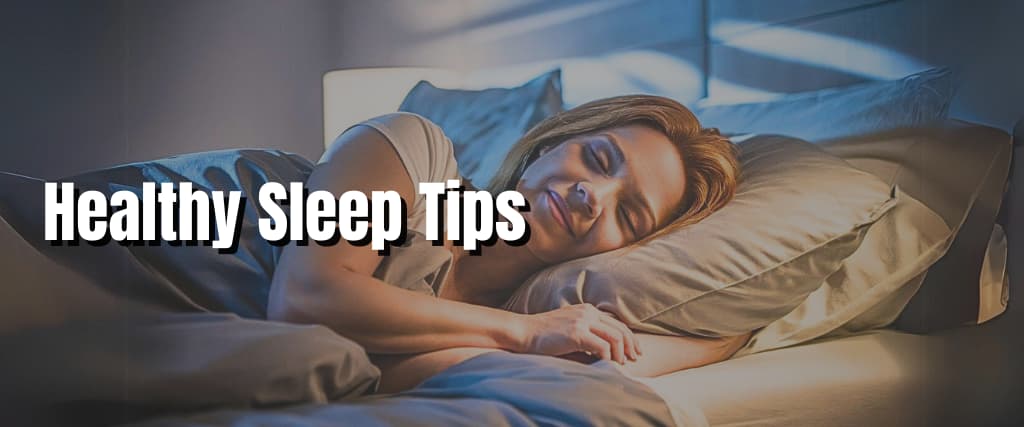Most couples lose sleep due to chronic snoring. Snoring is as a result of too much relaxation of the tongue, mouth, and throat tissues. A telltale snoring sound is produced due to the vibrations in the tissues caused by the air passing through. Snoring can be a sign of a serious medical condition or can be very disruptive.
Luckily snorers can find relief as there are mouthpieces that are perfectly designed to reduce snoring. These devices are known as mouthguards, and they fall into two categories. The first category is the MADs or the Mandibular advancement devices. These devices fit in your mouth and open your air passage by advancing your jaw. The second is the TRDs or Tongue retaining devices. This device grips the tongue and prevents it from falling into the back of the throat, which is a common cause of snoring for back sleepers.
As the Sleep Foundation team, we tested several anti-snoring mouthpieces and mouthguards and produced a list of reliable picks. Each pick was based on product research and brand and addition testing for both MADs and TRDs.

The Overview of Top picks
Best Mouthpiece General: SnoreRx Plus
Best Anti-Snoring TRD: Good Morning Snore Solution
Best Customizable Mouthpiece: Sleep Tight Mouthpiece
Most Comfortable Mouthguard: ZQuiet
Best Mouthpiece in Value: VitalSleep
To learn more about each of our mouthpieces, we have summarized our findings. Here you will find general information about anti-snoring devices, both mouthpieces and mouthguards, the merits and demerits of each device, how to use these devices, and additional methods of minimizing snoring.
Product Details
Best Mouthpiece General

SnoreRX Plus
Price: $124
Type of Mouthpiece: Mandibular advancement device
Who it’s best for:
- Individuals who prefer the feel of MAD
- People in need of customizable mouthpiece
- Persons whose jaw position vary every night
Highlights:
- Can be adjusted in 1mm increment up until 6mm
- Offers complete lateral movement
- Customizable through boil-and-bite molding
The SnoreRX Plus mouthpiece is designed for boil and bite molding. The device comes with a plastic handle positioned in the middle of the lower and upper trays. Boil water and put in a cup, and place the SnoreRX fitting, including the handle in the cup. Ensure that the whole piece is submerged for one minute.
After a minute has elapsed, take out the device using its handle and submerge it into a cup of tap water for about two seconds. At this point, you will be ready to bite down onto the SnoreRX for 30 seconds using your lower and upper teeth.
The mouthpiece also offers full lateral adjustment settings. The SnoreRX has feature tabs on both sides with measurements of 1 mm up to 6mm with an arrow to show the existing setting. To adjust the advancement levels, squeeze the upper tray on both sides, ensuring that each side is in the same setting. Before adjusting the device, always remember to remove it from your mouth. Read to find out more about SnoreRX mouthpieces.
Most users prefer the 3mm to 5mm setting, according to SnoreRX. The company suggests using a specific setting for about three to five nights before making new adjustments.
Compared to average MADs, SnoreRX Plus is budget-friendly. The mouthpiece has a 30-night trial period that comes with a full refund, except for shipping costs. SnoreRX makes deliveries to the United States, Australia, Canada, and most European Union countries.
Best Anti-Snoring TRD
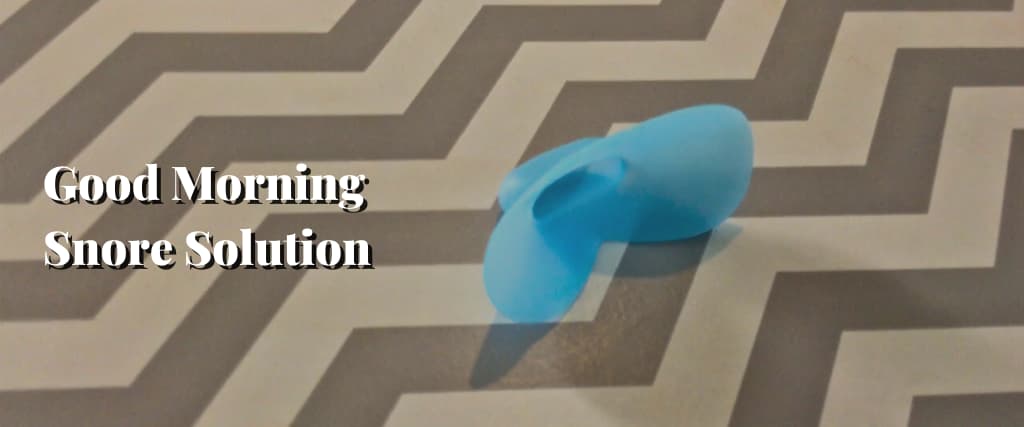
Good Morning Snore Solution
Price: $90
Type of Mouthpiece: TRD
Who it’s ideal for:
- Sleepers who desire the sensation of a tongue-retaining device
- Individuals looking for a mouthpiece that is lightweight and compact
- People experiencing jaw pain and conditions that prevent them from using a MAD
Highlights:
- Has a lightweight and compact design
- Requires no adjustment as it is a universal fit
- Tender on the jaw
The Good Morning Snore Solution is an extraordinarily lightweight anti-snoring mouthpiece. The device is well-designed for universal fit. It is also pear-shaped with a slot to fit your tongue. The tongue is put in place by gentle suction, which prevents it from falling back into the throat, which might result in snoring when the airway is blocked. Due to this reason, if you are a back sleeper, you might gain a lot using the Good Morning Snore Solution.
The manufacturers recommend putting the mouthpiece thin flange between the teeth and the lower lip, then sucking the air out while pinching the rounded area with your fingers. Put your tongue in the slot while relaxing as you stop squeezing. The round part will extend from the mouth, making stomach sleeping impossible, and certain users might experience a hard time swallowing at first. Nonetheless, most snores have a few night episodes trying to keep their tongue in place instead of advancing their jaw. To take out the device, squeeze the round part and remove your tongue.
TRDs and the Good Morning Snore Solution are ideal for individuals who find it hard to use MAD. These comprise people with braces, dentures, or dental implants. Individuals who have jaw pain problems and temporomandibular joint dysfunction are also not allowed to use these devices. However, TRDs can also be effective in minimizing teeth grinding. A piece of Good Morning Snore solution goes for about $90. However, you can buy two pieces for $130. Last but not least, this TRD is backed with a trial period of 30-night sleep.
Best Customizable Mouthpiece
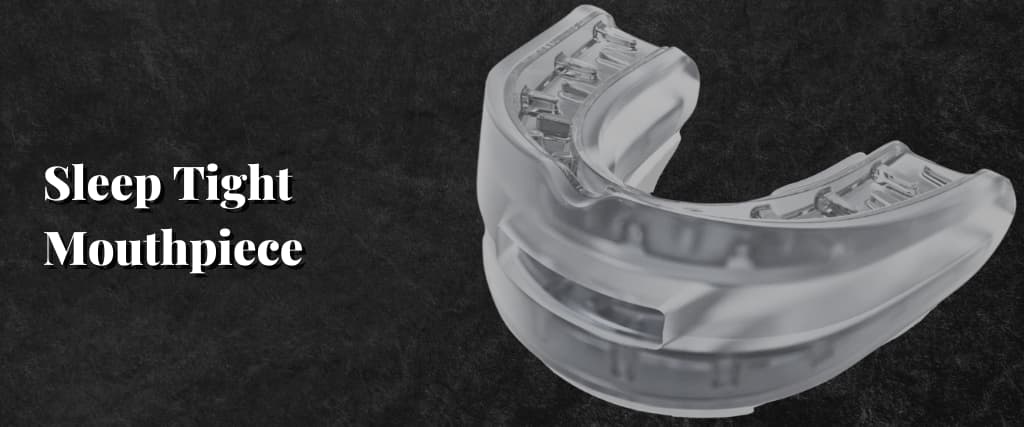
Sleep Tight Mouthpiece
Price: $80
Type of Mouthpiece: MAD/TRD combination device
Who it will serve best:
- Heavy snorers and individuals with obstructive sleep apnea
- Buyers who like to try out a mouthpiece before committing to it
- People who fancy mouthpieces with customized fits
Highlights:
- Contains no BPA or any latex
- The design is customizable; it can be refitted as required
- Customers can test the mouthpiece for 30 nights before finalizing their purchase
As a customer, you must pay in full for the most customizable anti-snoring mouthpiece, and you are allowed to return it at a later date if you are not satisfied. When it comes to Sleep Tight Mouthpiece is quite different as each buyer receives 30 nights to try out the device before deciding if the device is ideal. As a buyer, however, you ought to pay a small trial fee, and you won’t be required to finalize the payment of the mouthpiece until the trial period expires.
The Sleep Tight Mouthpiece adjusts the jaw and pulls the tongue forward to decrease snoring with its combined anti-snoring features. The device has a large airway of 6mm for individuals that breathe through their mouths while asleep. The opening is also vital as it helps retain the tongue to open the air further. The jaw advancement is set at 5mm; however, it can be adjusted if more reliance is required after the first few nights.
Suppose you decide on this device; its price is still less compared to the average customizable MAD. In the U.S., the trial fee covers the shipping fee for orders made.
Most Comfortable Mouthguard

ZQuiet
Price: $100
Type of Mouthpiece: MAD
Who it’s ideal for:
- Individuals looking for a mouthpiece that adjusts automatically
- Persons who desire a mouthpiece that manually advances the jaw
- People who want value for their money
Highlights:
- Adjusts in the mouth and jaw automatically without molding
- Its design is hinged
- Comes in a set of two devices with different degrees of jaw advancement
ZQuiet is pretty different from the usual boil-and-bite mouthpiece. This device is fitted with a hinge connecting the upper and lower trays. Additionally, MAD adjusts automatically to the dimensions of your jaw and mouth without any customization or mold. This makes the mouthpiece comfortable, easy, and hassle-free to use. In addition to this, you also enjoy easier side-to-side movement. The device also allows you to breathe easily because it allows steady airflow due to its thin profile.
When buying ZQuiet, you purchase two separate devices. One of the devices advances your jaw by 2mm, and the other advances it by 6mm. You might prefer one compared to the other. If not, you can use the two devices if your jaw advancement varies from one night to the next. The ZQuiet is composed crafted from soft thermoplastic and does not have BPA or latex. Storage containers to keep your device hygienic and clean are included when you make your purchase.
The device costs $79.95, which is a reasonable price for a MAD- mainly if you use the two devices interchangeably. ZQuiet offers a 60-night sleep trial and recommends replacing the devices after six months. The company offers standard and expedited shipping. Same-day shipping is available for orders made before 11 am Eastern Standard Time.
Best Mouthpiece in Value

VitalSleep
Price: $100
Type of mouthpiece: MAD
Who it’s ideal for:
- Individuals who fancy the feel of MAD
- People Searching for a customizable mouthpiece
- Individuals whose jaw placement preferences differ from one night to the next and the best mattress.
Highlights:
- Adjustable 1mm increments up to 8mm
- Boil and bite customization
- Free adjustment tool encompassed with purchase
VitalSleep is a boil-and-bite mouthguard finished with soft thermoplastic material. Put the MAD in hot water, then bite down the thermoplastic to ensure that the device fits perfectly into the contours of your gums and teeth. (Use our guide on molding and preparing a boil-and-bite mouthpiece.)
The VitalSleep mouthpiece can be adjusted in 1mm to 8mm. It allows every individual to use it comfortably irrespective of how their lower jaw is shaped. A small device is encompassed to adjust the lower tray and advance the jaw, which improves breathing by opening the snorer’s airway. The device comes in a universal-fit size; it is hypoallergenic and contains no latex or BPA.
VitalSleep devices are more comfortable and well-priced than the average MAD. The company offers free delivery around the world, and all orders are shipped on the same day. You can receive your device within two days by mail or wait much longer if you live in rural areas. The device has a 2-year warranty and is backed by a 60- night trial period. The device offers the best deal, as it is backed by a more extended sleep trial period than most MADs and has warranty coverage.
Why You Should Trust Us
Our team comprises professionals, each with much experience in testing, evaluating, and researching sleep products. Before settling on the top picks listed above, we tested more than a dozen anti-snoring mouthguards and mouthpieces. These comprise both MADs and TRDs.
The assessment process included testers sleeping and wearing each mouthpiece for at least a night. Much focus was placed on testers who frequently or occasionally snore. Individuals who don’t usually snore offered more feedback on things such as ease of customization and overall comfort. The above picks show the collective findings of our professionals.

How to Select an Anti-Snoring Mouthguard or Mouthpiece
One of the crucial factors that you need to consider when choosing an anti-snoring mouthpiece is knowing whether you prefer the manual jaw adjustment of a MAD or you desire the tongue-restraining suction of a TRD. Well, it’s essential to note that these devices might need an adjustment period as you become familiar with their feel, especially when trying to sleep.
The cost of most over-the-counter MADs and TRDs go for $50 and $150 per device. Prior to making a purchase, it is wise to consult your physician to determine which is best suited for you. Doctors may also provide tips and recommendations on devices that work best.
Who Should Consider An Anti-Snoring Mouthpiece?
Currently, there is no known cure for snoring. However, the finest snoring aids will decrease the symptoms significantly. Most people who snore gain a lot from using anti-snoring devices. About 90 million adults nationwide experience snoring. Snoring is chronic for more than one-third of these sleepers, if not a nightly problem.
Snoring is as a result of restricted airflow through the breathing track. This might be; a result of several things. For example, if you have a relatively big soft palate that hangs low, you are likely to experience snoring as your airway is narrower. Extra tissues can accumulate around the airway when you are overweight or obese resulting in snoring.
Alcohol can also cause snoring when you drink before going to sleep as it makes your throat relax too much. Because of this, the tongue falls back into the throat, blocking the airway. When tired or sleep-deprived, the throat muscles may also relax excessively.
In addition, sleeping on your back leaves you at risk of snoring as the tongue is likely to block the airway.
In the long run, chronic snoring can result in other conditions. These conditions comprise mood swings and angry outbursts, daytime sleepiness and fatigue, trouble focusing on tasks, and a higher risk of workplace or vehicle accidents. MAD and TRD mouthpieces can reduce snoring episodes in people with non-apnea snoring-related issues. The devices are pretty affordable compared to medical procedures or surgery designed to treat snoring. Talk to a specialist before buying a MAD or TRD or using one for the first time.
Although these devices might be effective for many people, they might not work for you. Most individuals find these devices painful and uncomfortable. In addition, these devices are futile at treating serious snoring conditions like sleep apnea.

How Do Anti-Snoring Mouthpieces Work?
Despite efficiency against snoring for most individuals, anti-snoring devices are a bit straightforward with small individual parts. How the mouthpiece functions depend on whether it is a MAD or TRD.
The most common anti-snoring devices are the MADs. A more significant number of these mouthpieces have thermoplastic material in the upper and lower trays where your teeth are supposed to fit. When submerged in boiling water, the thermoplastic will soften, and you will be in a position to bite down into both trays, making a mold that is customized. Unless otherwise stated in the instructions, the guideline of the “boil-and-bite” process is as follows.
- Try on the mouthpiece by gently biting down the thermoplastic in the upper and lower trays before boiling. The suitable size device should come off your lips with a couple of millimeters.
- Some devices might force you to trim the ends of the upper and lower trays so that the mouthpiece can fit properly. This step may be unnecessary for other devices.
- Boil water in a microwaved cup or a pot on your stovetop (subject to guidelines given). After boiling water, place it in a container on a non-heated surface. Ensure that there is adequate water in the container to submerge the mouthpiece.
- Immerse the device in the boiled water for 30 to 60 seconds, depending on the guidelines provided.
- Put the mouthpiece in cold water for a few seconds to cool off. Some models might be ready to mold, although it is best to let the thermoplastic cool off for a few seconds before you bite down into it.
- Place the mouthpiece in your mouth, bite down firmly with your lower and upper teeth. The thermoplastic should feel warm; if still hot, allow it to cool more. Press your tongue against the roof of your mouth while doing so—this aids in drying off the mouthpiece.
- If the first mold was unsuccessful, redo the steps. To allow several attempts, the thermoplastic needs to soften enough.
Suppose the molding was successful; the MAD will advance your jaw by roughly 1mm when put in the mouth with your teeth on the upper and lower trays. Models such as VitalSleep and SnoreRX, which are customizable, can be adjusted manually in increments of 1mm to ensure a comfortable advancement level. Other MAD devices like ZQuiet adjust automatically using a flexible hinge that takes the shape of your mouth and jaw. By moving the jaw forward, MADs can reduce the risk of snoring by widening the airway passage, thus allowing an easier flow of air.
TRDs, on the other hand, are pretty straightforward. These devices bear a resemblance to the pacifier used by infants and babies. The device is fitted out with flanges that rest against the inner and upper folds of the upper and lower lip and has a protrusion where the tongue fits. The opening is narrow to facilitate suction, and it helps keep the tongue near the mouth front and away from the back of the throat. The design of TRDs is a universal fit; thus, you need not to follow boil-and-bite guidelines to customize their fit.
Types of Anti-Snoring Mouthpieces: MADs vs. TRDs
Having known how MADs and TRDs work, let’s now look at how these devices compare to each other. Both MADs and TRDs can help reduce snoring episodes in individuals. Nevertheless, each type of mouthpiece has its merits and demerits.
MADs
Pros
- Boil-and-bite molding crafts a customized impression of your upper and lower teeth
- Most MADs can be adjusted for different advancement levels
- Advancing the jaws helps individuals to breathe through their mouths relatively easily
- MADs can be used with any sleep position since the device does not protrude from the mouth
- MADs can assist in reducing nighttime bruxism (or teeth-grinding)
Cons
- Using MAD model, a prescription is necessary
- The mouthpiece sides effects like dry mouth, drooling, jaw pain, and stiffness
- Some individuals are not allowed to use MADs. These comprise people with dentures, dental implants, braces, and broken or cracked teeth. Individuals with TMJ or other jaw discomfort conditions should avoid using MADs as they can increase pain.
- Although considered reasonably priced for most buyers, MADs are still expensive compared to TRDs.
TRDs
Pros
- TRDs don’t require boil-and-bite molding guidelines as they are made for universally fit
- TRDs are lighter and compact compared to MADs
- TRDs do not interfere with dental implants, dentures, or braces
- Generally, TRDs are cheaper than MADs
Cons
- Most TRDs can’t be customized to a specific setting because the devices are one-size-fits-all design
- TRDs do not prevent bruxism because they don’t separate the teeth.
- TRDs might limit breathing through the mouth
- Some of the side effects of using TRDs constitute drooling and dry mouth
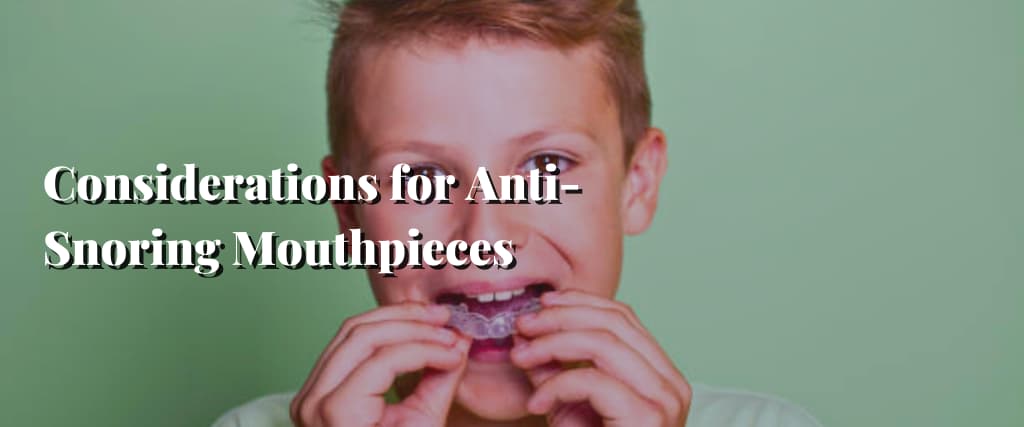
Considerations for Anti-Snoring Mouthpieces
Mandibular advancement devices and tongue-retaining devices aid in achieving similar outcomes; That is, less snoring by using different methods and means. When deciding on the best device, consider these elements.
Customization: MADs give the most customization options. A more significant number of these mouthguard designs are boil-and-bite type. The trays are created using thermoplastic, giving you a chance to create a customized mold for your teeth. On the other hand, TRDs do not offer this type of customization. This is because most of these devices are universally fit designs. However, some models come in several sizes for maximum comfort for different individuals.
Quality Material: Most mouthguards are made using plastic, silicone resin, or both materials. Moldable thermoplastic is used to make entirely or partially boil-and-bite MADs. Mouthpieces made nowadays do not contain either BPA plastic or latex. Most devices are made to last for about six months to two years before a replacement is required.
Comfort: Individual preferences differ regarding anti-snoring devices—some people may prefer the jaw-advancing feel of MADs or a tongue retaining the suction of TRDs. As an individual, you might want to consider both to determine which device is more comfortable. In this case, models with trial periods are best considered. You can also consult your doctor about MADs and TRDs to know your best option, then proceed from there.
Adjustability: When it comes to MADs, you can adjust how far the device advances your jaw. For example, referring to our top picks, the VitalSleep may be adjusted in 1mm increments up to 6mm, SnoreRX also can be adjusted in similar increments up to 8mm. Conversely, ZQuiet adjusts itself automatically to the user’s mouth because it features a hinge mechanism. TRDs, on the other hand, cannot be adjusted due to their design.
Ease of cleaning: We suggest cleaning your anti-snoring mouthpiece in hot water after using it for maximum results. In case you use MAD, you need to scrub the upper and lower trays to prevent bacteria accumulation. Some companies offer a complete cleaning solution for their MADs. A toothbrush and toothpaste may also work when cleaning your mouthpiece. Clean the interior of the tongue opening if you use TRD. Most anti-snoring mouthpieces have their protective cases; if not, ensure the device is placed in a clean environment when not in use.
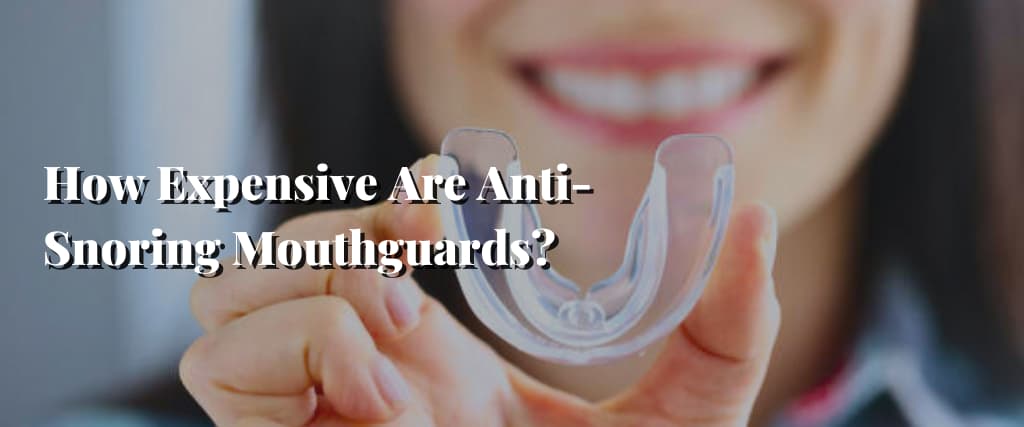
How Expensive Are Anti-Snoring Mouthguards?
These devices usually cost between $50 and $150 per mouthpiece. MADs are quite expensive. Their price ranges from $75 to $150 apiece. TRDs are priced at $100 or less. Shipping costs may be included or not, depending on a company’s delivery policy. However, full refunds are usually given if returns are accepted. Additionally, some brands offer their anti-snoring mouthpieces at a discounted rate if you buy two or more in one purchase.
For a device that might require a replacement after two years, $50 to $150 appears rather expensive. However, anti-snoring mouthpieces cost less compared to upper airway surgery or medical systems aimed at treating snoring symptoms.
Other Vital Concerns about Anti-Snoring Mouthpieces
Are they safe for every individual?
Anti-snoring mouthpieces are usually considered safe. Nevertheless, you ought to consult a doctor before using one for the first time.
Mouthguards can lead to TMJ conditions because these devices advance the jaw forward. This condition is known for pain in the jaws and adjacent muscles. TRDs and MADs may also cause pain and irritation to gums and teeth, particularly if the mouthpiece is custom molded.
It is also essential to ensure your anti-snoring mouthpiece is clean. Clean the device frequently and sterilize it with hot water to avoid the accumulation of harmful bacteria.
Ahead of buying any anti-snoring mouthpiece, conduct your research on the top brands to determine if any shortcomings or safety concerns are linked with those products. Furthermore, you contact customer service staff to ask about any possible safety concerns you need to watch out for.
How essential is certification and what must I look for?
MADs, TRDs, and other mouthpiece devices for snoring or sleep apnea are regarded as Class II medical devices under the United States Food and Drug Administration (FDA). This implies that these devices present risk to users as they come in direct contact with the body. Because of this, the FDA controls the distribution and sale of these mouthpieces.
These devices must undergo testing and be verified as effective before the FDA clears them to fit for users. Each anti-snoring mouthpiece you purchase should have a “cleared by FDA” tag.
Do I require a prescription?
Many devices are sold over the counter and do not necessitate a prescription. Nonetheless, you will require a prescription for specific MAD or TRD models plus some advanced customized mouthguards. In case there are any prescription requirements, they will be listed on the online product page for these anti-snoring mouthpieces.
How does custom fitting work?
The boil-and-bite customization is designed for most MADs mouthpieces. Just immerse the mouthpiece in boiled water to facilitate the softening of upper and lower trays made of thermoplastic material. Remove the device from boiled water, cool then bite down on the thermoplastic trays. (Detailed instructions differ by model)
For the most expensive custom devices, you may be required to make a mold and then mail the sample to the manufacturers, who will afterward produce a device custom-fitted to your jaw and teeth.
Other MADs like ZQuiet automatically adjust by using hinges and other mechanisms, so customization is unnecessary. TRDs, on the other hand, are usually not customizable since they have a one-size-fits-all design.
Can I wear it with dentures?
Avoid using MAD mouthpieces if you wear dentures. These devices are designed to move the jaw forward physically. Using them can dislodge or interfere with dentures. MADs are also not ideal for individuals with loose teeth or implants. TRDs, on the other hand, are denture friendly as they do not mold to the teeth. However, it is wise to talk to your physician to ensure these mouthpieces are right for you.
Do mouthpieces prevent bruxism (teeth grinding)?
Bruxism can be prevented or minimized by using MADs. The mouthpiece has lower and upper trays to separate the teeth. Suppose the device is fitted perfectly. It will help separate your upper and lower teeth from coming into contact. TRDs do not prevent bruxism because they hardly separate the teeth.

How do I clean my mouthpiece?
Each model has different cleaning instructions. However, it is essential to sterilize the mouthguard with hot water after using it. Regularly scrub the device with the right cleaning solution to prevent bacteria accumulation. It is also vital to store the device in a cool place like the bathroom cabinet to prevent it from being open to excessive moisture or heat. Luckily most manufacturers provide protective cases for their mouthpieces.
Do mouthguard manufacturers offer returns? What about warranties?
Most devices usually come with a trial period of 30 to 60 nights. This provides you with a chance of using the device for at least a month before making up your mind or whether to return it or keep it. Unfortunately, shipping charges are ordinarily nonrefundable.
Warranties are not common. However, several MAD and TRD models are covered by the manufacturer’s assurance. If the device has a warranty, it will probably cover the mouthpiece for up to a year.
Additional Snoring Solutions and Products
MAD and TRD are very effective for most individuals. Unfortunately, these mouthpieces might not be ideal if you have severe chronic snoring. Here are other options for treating snoring.
CPAP, BiPAP, and APAP
Sleep apnea is a disorder characterized by heavy snoring and temporary loss of breath at night. Obstructive sleep apnea (OSA) results from a physical obstacle blocking the airway, for example, abnormal tissue build-up or the tongue. Central sleep apnea (CSA) takes place when the brain is unable to convey signals to muscles that help in breathing.
Positive air pressure (PAP) therapy might help reduce the occurrence or severity of nighttime episodes for people suffering from sleep apnea. This encompasses using a machine that draws in the air using a fan. It humidifies and pressurizes the air and then delivers it to an individual through a connective hose and face mask covering the nostrils and mouth. The three common PAP therapy types include;
Continuous positive air pressure (CPAP): The machine delivers air to the user at a prescribed pressure rate during this therapy. This method is efficient in treating OSA.
Bi-level positive air pressure (BiPAP): For this therapy, the pressure toggles in the middle of a higher rate of exhalation and a lower inhalation rate, which makes breathing simple for some individuals.
Automatic positive air pressure (APAP): This does not follow a fixed pressure schedule. However, the machine adjusts pressure based on the breathing patterns of the user. The therapy is successful for both OSA and CSA.
A doctor’s prescription is necessary for PAP machines, facemasks, and humidifiers. If you experience sleep apnea, talk to a specialist to gather more information.
Alternate Devices
Other devices can combat snoring apart from MADs and TRDs. Another helpful device is Provent, which is majorly used in treating sleep apnea signs. Provent is made up of two air filters that are put inside each nostril. The non-invasive device may decrease snoring occurrences by a significant level. However, you will require a doctor’s recommendation to buy Provent.
A palatal lift prosthesis is another option for severe snoring issues. The prostheses are crucial in treating palatopharyngeal incompetence, a disorder that makes it impossible to close the nasal passages when swallowing or speaking. This can result in OSA and chronic snoring. The prostheses help in elevating the soft palate widening the air passage, thus promoting proper circulation. For the prosthesis to be installed, you’ll need to undertake a medical procedure. However, this may not be a cost-effective option.
Surgery
Mayo clinic recommends undergoing surgical procedures if you have a severe snoring issue. Some of the techniques that can help reduce snoring comprise uvulopalatopharyngoplasty. During this procedure, surgeons broaden the airway by removing tissues from the back of your throat.
Another procedure is radiofrequency tissue ablation, which includes low-intensity signals that decrease tissues around the throat, palate, and tongue. Finally is maxillomandibular advancement surgery involves permanently moving the upper and lower jaws.
Medical researchers keep on discovering new treatment techniques. A recent innovation is hypoglossal nerve stimulation. The procedure involves reprogramming the nerves that control your tongue’s movement so that they can prevent airway blockage.
Even though you have health insurance, surgery can be costly. Therefore opting for any of these procedures should be a last resort.
Pillow Lofts and Adjustable Beds
People who lie on their backs are more vulnerable to snoring than individuals who use other sleeping positions. This is because their tongue is more likely to fall into the back of the throat, blocking the air passage. To curb snoring, back sleepers need more pillow lofts to elevate their head so that they can keep their tongue closer to the front of the mouth. If your head falls back into your head, you ought to change your sleeping posture, or you need to get a thicker pillow.
Snoring back sleepers can also benefit from adjustable beds. These beds can effortlessly be raised or lowered at the head or foot giving you the comfort of sleeping with your head elevated and the rest of the body resting flush with the bed. The demerit: Adjustable beds are costly.
Lifestyle Adjustments
Changing your daily and nightly routines can help you experience less snoring. Being obese and overweight are considered risk factors as an individual; therefore, losing weight can reduce snoring to a great extent. Reducing alcohol consumption and smoking prior to bedtime can help reduce episodes of snoring.
If you have chronic snoring and usually sleep on your back, then it’s best to consider sleeping on the side position. While lying on your side, your tongue can’t fall into the back of your throat. Sleeping on your stomach can also curb air blockage. Unfortunately, this posture is linked to more pains and aches and is thus highly discouraged.
Finally, getting enough sleep might be a solution to less snoring. If you go to bed feeling sleep-deprived, there are high chances that your throat will relax excessively, leading to air blockage. As an adult, ensure that you sleep for 7-9 hours every night, including weekends.
Frequently Asked Questions
What anti-snoring mouthpiece is right for me?
The best anti-snoring mouthguard or mouthpiece relies on your preference. Mouthpieces fall in one of two groups. Mandibular advancement devices (MADs) have upper and lower trays made to fit around your teeth and advance the jaw forward. The device helps increase the airway allowing more air to pass through.
Most MADs are boil-and-bite mouthpieces created using thermoplastic. As a user, you are supposed to submerge the device in boiled water and bite down into the thermoplastic to form a customized mold. The device will be perfect to use after it cools and hardens. MADs can also be made using the exact dental impression of a customer, and others can be modified for advancement levels.
MADs are pretty effective due to their customization nature. These devices allow users to breathe through their mouth and the absence of protruding part indicates that the anti-snoring mouthpiece can be used with any sleep position. Nevertheless, MADs are linked to some side effects such as jaw pain, drooling, and stiffness. Most people comprising those with dentures or braces can’t be able to use them, and a prescription is essential.
The tongue retaining device (TRD) is the other anti-snoring mouthpiece. This device is designed with a small section for the tongues with flanges that rest against your lip. The protrusion present is for suctioning the tongue, keeping it in place, and stopping it from dropping back into the throat, which is a significant source of snoring.
TRDs are a bit lighter and simple to put on than most MADs. These mouthpieces are not linked to adverse effects, won’t interfere with braces or dentures, and a number do not necessitate a prescription. Even so, TRDs do not allow customization as they are a one-size-fits-all design, and thus they serve other people better than others. Additionally, they can also prevent as they form a closure around the mouth.
Do mouthguards and mouthpieces really stop snoring?
Mouthpieces, particularly custom-fitted models, can effectively treat heavy snoring. Other lifestyle habits such as consuming alcohol before bed and sleeping on your back are common causes of snoring. However, avoiding sleeping on your back and drinking alcohol before bedtime can help reduce snoring episodes if you use a mouthpiece.
Most people snore because of the disorder referred to as Obstructive sleep apnea (OSA). The condition promotes heavy snoring and causes people to wake up through the night choking and gasping for air. Although mouthpieces can mitigate snoring, CPAP or BiPAP machines are ideal for treating OSA conditions.




